Talent Management Strategies: A Case Study of ASOS - Unit 6 Project
VerifiedAdded on 2023/06/17
|19
|3580
|186
Project
AI Summary
This project report investigates talent management strategies, focusing on a case study of ASOS. The research aims to understand how leading companies attract and retain talent, examining the concept of talent management and its strategies, issues, and hurdles in managing and retaining employees, and effective talent management strategies for ASOS. The project plan includes scope definition, milestones, initiation, planning, and execution phases, with a timeline tracked using a Gantt chart and work breakdown structure. Research philosophies, including realism, objectivism, interpretivism, and pragmatism, guide the approach, utilizing both deductive and inductive research methods. Data collection involves primary methods (questionnaires and surveys) and secondary methods (literature review). Ethical considerations are addressed to ensure research integrity. Quantitative analysis reveals employee awareness and perspectives on talent management, while qualitative analysis incorporates literature review findings. Recommendations are provided for improving talent management practices within ASOS. The report concludes with a reflection on the learning gained from the research process.
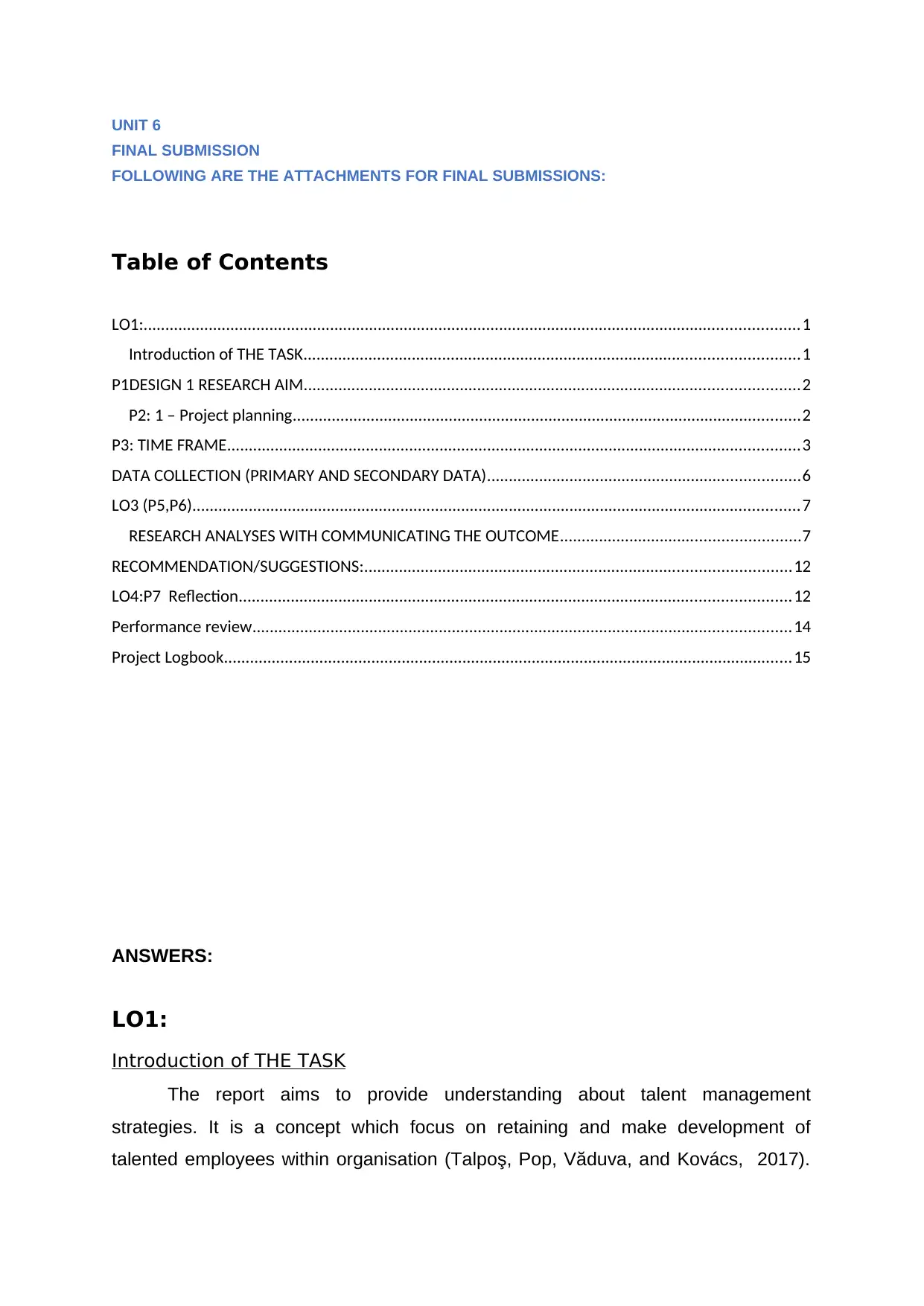
UNIT 6
FINAL SUBMISSION
FOLLOWING ARE THE ATTACHMENTS FOR FINAL SUBMISSIONS:
Table of Contents
LO1:.......................................................................................................................................................1
Introduction of THE TASK..................................................................................................................1
P1DESIGN 1 RESEARCH AIM..................................................................................................................2
P2: 1 – Project planning.....................................................................................................................2
P3: TIME FRAME....................................................................................................................................3
DATA COLLECTION (PRIMARY AND SECONDARY DATA)........................................................................6
LO3 (P5,P6)............................................................................................................................................7
RESEARCH ANALYSES WITH COMMUNICATING THE OUTCOME.......................................................7
RECOMMENDATION/SUGGESTIONS:..................................................................................................12
LO4:P7 Reflection...............................................................................................................................12
Performance review............................................................................................................................14
Project Logbook...................................................................................................................................15
ANSWERS:
LO1:
Introduction of THE TASK
The report aims to provide understanding about talent management
strategies. It is a concept which focus on retaining and make development of
talented employees within organisation (Talpoş, Pop, Văduva, and Kovács, 2017).
FINAL SUBMISSION
FOLLOWING ARE THE ATTACHMENTS FOR FINAL SUBMISSIONS:
Table of Contents
LO1:.......................................................................................................................................................1
Introduction of THE TASK..................................................................................................................1
P1DESIGN 1 RESEARCH AIM..................................................................................................................2
P2: 1 – Project planning.....................................................................................................................2
P3: TIME FRAME....................................................................................................................................3
DATA COLLECTION (PRIMARY AND SECONDARY DATA)........................................................................6
LO3 (P5,P6)............................................................................................................................................7
RESEARCH ANALYSES WITH COMMUNICATING THE OUTCOME.......................................................7
RECOMMENDATION/SUGGESTIONS:..................................................................................................12
LO4:P7 Reflection...............................................................................................................................12
Performance review............................................................................................................................14
Project Logbook...................................................................................................................................15
ANSWERS:
LO1:
Introduction of THE TASK
The report aims to provide understanding about talent management
strategies. It is a concept which focus on retaining and make development of
talented employees within organisation (Talpoş, Pop, Văduva, and Kovács, 2017).
Paraphrase This Document
Need a fresh take? Get an instant paraphrase of this document with our AI Paraphraser
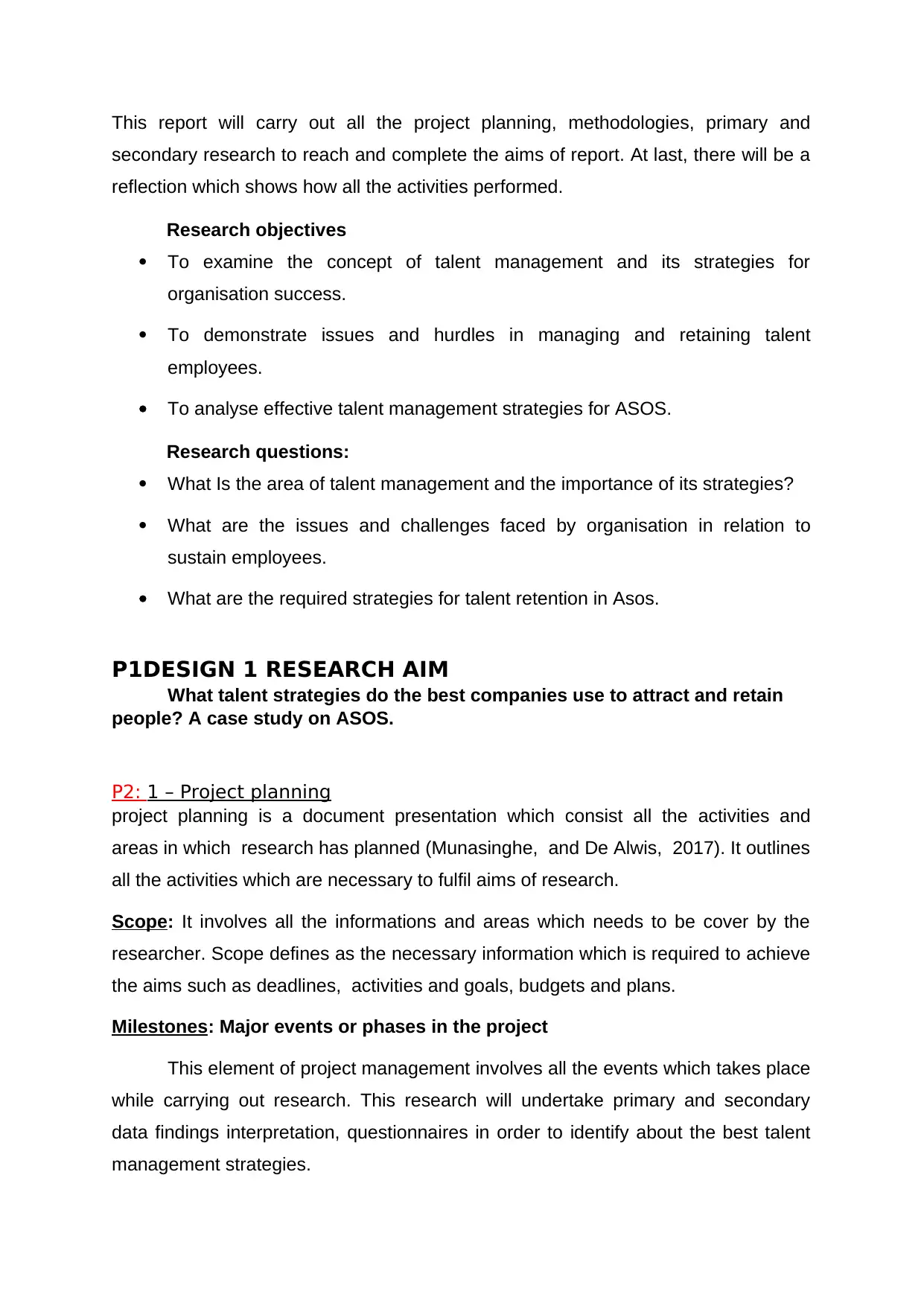
This report will carry out all the project planning, methodologies, primary and
secondary research to reach and complete the aims of report. At last, there will be a
reflection which shows how all the activities performed.
Research objectives
To examine the concept of talent management and its strategies for
organisation success.
To demonstrate issues and hurdles in managing and retaining talent
employees.
To analyse effective talent management strategies for ASOS.
Research questions:
What Is the area of talent management and the importance of its strategies?
What are the issues and challenges faced by organisation in relation to
sustain employees.
What are the required strategies for talent retention in Asos.
P1DESIGN 1 RESEARCH AIM
What talent strategies do the best companies use to attract and retain
people? A case study on ASOS.
P2: 1 – Project planning
project planning is a document presentation which consist all the activities and
areas in which research has planned (Munasinghe, and De Alwis, 2017). It outlines
all the activities which are necessary to fulfil aims of research.
Scope: It involves all the informations and areas which needs to be cover by the
researcher. Scope defines as the necessary information which is required to achieve
the aims such as deadlines, activities and goals, budgets and plans.
Milestones: Major events or phases in the project
This element of project management involves all the events which takes place
while carrying out research. This research will undertake primary and secondary
data findings interpretation, questionnaires in order to identify about the best talent
management strategies.
secondary research to reach and complete the aims of report. At last, there will be a
reflection which shows how all the activities performed.
Research objectives
To examine the concept of talent management and its strategies for
organisation success.
To demonstrate issues and hurdles in managing and retaining talent
employees.
To analyse effective talent management strategies for ASOS.
Research questions:
What Is the area of talent management and the importance of its strategies?
What are the issues and challenges faced by organisation in relation to
sustain employees.
What are the required strategies for talent retention in Asos.
P1DESIGN 1 RESEARCH AIM
What talent strategies do the best companies use to attract and retain
people? A case study on ASOS.
P2: 1 – Project planning
project planning is a document presentation which consist all the activities and
areas in which research has planned (Munasinghe, and De Alwis, 2017). It outlines
all the activities which are necessary to fulfil aims of research.
Scope: It involves all the informations and areas which needs to be cover by the
researcher. Scope defines as the necessary information which is required to achieve
the aims such as deadlines, activities and goals, budgets and plans.
Milestones: Major events or phases in the project
This element of project management involves all the events which takes place
while carrying out research. This research will undertake primary and secondary
data findings interpretation, questionnaires in order to identify about the best talent
management strategies.

Initiation, planning and execution: Details of activities to be carried in the
project
Initiation: it is the foremost stage of project planning. In this the researcher
comes along with various ideas and thoughts about the relevant research topic. The
idea must be applicable in all fields and support an effective theory and aims. This
research will identify the talent management strategies which will be suitable for
Asos to retain and attract employees.
Planning: The plans must involve all the activities and task which are
required to complete project objectives (Sanyal, and Haddock-Millar, 2021). Planning
must be done in effective manner in which all the resources, costs and tasks are
identified.
Execution: once all the plans get made, the researcher needs to execute it
as per set objectives and targets. There must be proper control followed by
researcher to look at achieving project aims and objectives.
P3: TIME FRAME :
TOPIC 1 : RESEARCH TITLE AND RES AIM 3 WEEKS (1-3)
TOPIC 2: RES OBJV, BACK GRD, LIMITATION 2 WEEKS (2-3)
TOPIC 3: LIT REV 2 WEEKS (3-4)
TOPIC 4: METHODOLOGY 3 WEEKS (7-11)
TOPIC 5 : RES ANALYSES 4 WEEKS (10-12)
TOPIC 6: REPORT WRITING WITH FINDINGS AND RECC…. (3 WEEKS) (12-15)
Gantt chart: Work break down structure using to track the activities to be
undertaken
Gantt chart is an important tool which helps in delivering work activities by
setting specific time frames. It shows the start and end dates and time to complete
all the necessary task (Rajabipoor Meybodi,and Mohammadi, 2020). It is a graphical
representation which helps the researcher to manage important tasks on priority and
it makes assure that all the task must be fulfil in well manner.
Work breakdown structure:
project
Initiation: it is the foremost stage of project planning. In this the researcher
comes along with various ideas and thoughts about the relevant research topic. The
idea must be applicable in all fields and support an effective theory and aims. This
research will identify the talent management strategies which will be suitable for
Asos to retain and attract employees.
Planning: The plans must involve all the activities and task which are
required to complete project objectives (Sanyal, and Haddock-Millar, 2021). Planning
must be done in effective manner in which all the resources, costs and tasks are
identified.
Execution: once all the plans get made, the researcher needs to execute it
as per set objectives and targets. There must be proper control followed by
researcher to look at achieving project aims and objectives.
P3: TIME FRAME :
TOPIC 1 : RESEARCH TITLE AND RES AIM 3 WEEKS (1-3)
TOPIC 2: RES OBJV, BACK GRD, LIMITATION 2 WEEKS (2-3)
TOPIC 3: LIT REV 2 WEEKS (3-4)
TOPIC 4: METHODOLOGY 3 WEEKS (7-11)
TOPIC 5 : RES ANALYSES 4 WEEKS (10-12)
TOPIC 6: REPORT WRITING WITH FINDINGS AND RECC…. (3 WEEKS) (12-15)
Gantt chart: Work break down structure using to track the activities to be
undertaken
Gantt chart is an important tool which helps in delivering work activities by
setting specific time frames. It shows the start and end dates and time to complete
all the necessary task (Rajabipoor Meybodi,and Mohammadi, 2020). It is a graphical
representation which helps the researcher to manage important tasks on priority and
it makes assure that all the task must be fulfil in well manner.
Work breakdown structure:
⊘ This is a preview!⊘
Do you want full access?
Subscribe today to unlock all pages.

Trusted by 1+ million students worldwide

it is also an effective tool which helps in divide of work in smaller way. It
simplify the activities which reduce work complexities (Evans, Smale,and Björkman
2018). Therefore, this research is supported with all the research task in a
systematic manner.
simplify the activities which reduce work complexities (Evans, Smale,and Björkman
2018). Therefore, this research is supported with all the research task in a
systematic manner.
Paraphrase This Document
Need a fresh take? Get an instant paraphrase of this document with our AI Paraphraser
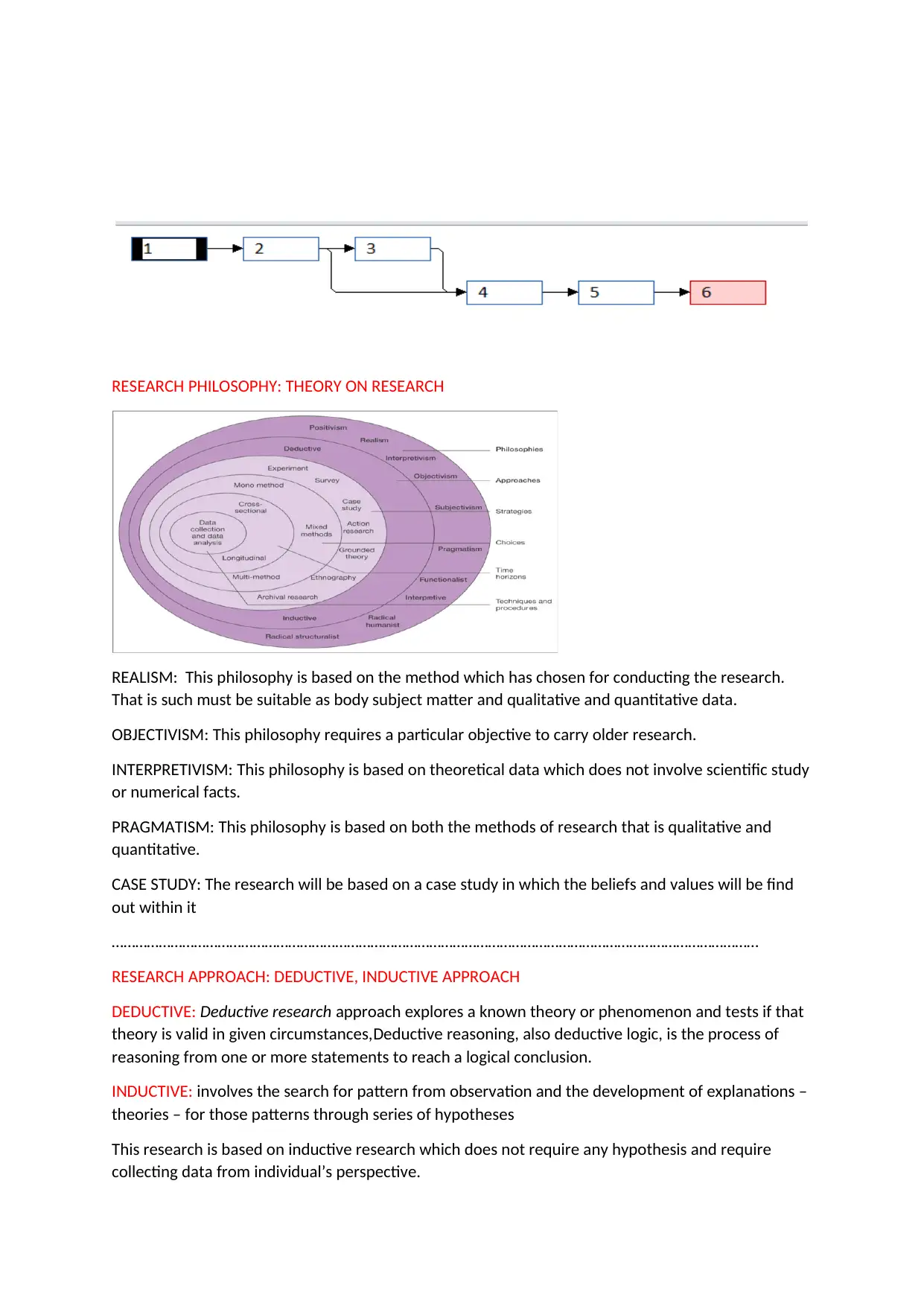
RESEARCH PHILOSOPHY: THEORY ON RESEARCH
REALISM: This philosophy is based on the method which has chosen for conducting the research.
That is such must be suitable as body subject matter and qualitative and quantitative data.
OBJECTIVISM: This philosophy requires a particular objective to carry older research.
INTERPRETIVISM: This philosophy is based on theoretical data which does not involve scientific study
or numerical facts.
PRAGMATISM: This philosophy is based on both the methods of research that is qualitative and
quantitative.
CASE STUDY: The research will be based on a case study in which the beliefs and values will be find
out within it
…………………………………………………………………………………………………………………………………………………
RESEARCH APPROACH: DEDUCTIVE, INDUCTIVE APPROACH
DEDUCTIVE: Deductive research approach explores a known theory or phenomenon and tests if that
theory is valid in given circumstances,Deductive reasoning, also deductive logic, is the process of
reasoning from one or more statements to reach a logical conclusion.
INDUCTIVE: involves the search for pattern from observation and the development of explanations –
theories – for those patterns through series of hypotheses
This research is based on inductive research which does not require any hypothesis and require
collecting data from individual’s perspective.
REALISM: This philosophy is based on the method which has chosen for conducting the research.
That is such must be suitable as body subject matter and qualitative and quantitative data.
OBJECTIVISM: This philosophy requires a particular objective to carry older research.
INTERPRETIVISM: This philosophy is based on theoretical data which does not involve scientific study
or numerical facts.
PRAGMATISM: This philosophy is based on both the methods of research that is qualitative and
quantitative.
CASE STUDY: The research will be based on a case study in which the beliefs and values will be find
out within it
…………………………………………………………………………………………………………………………………………………
RESEARCH APPROACH: DEDUCTIVE, INDUCTIVE APPROACH
DEDUCTIVE: Deductive research approach explores a known theory or phenomenon and tests if that
theory is valid in given circumstances,Deductive reasoning, also deductive logic, is the process of
reasoning from one or more statements to reach a logical conclusion.
INDUCTIVE: involves the search for pattern from observation and the development of explanations –
theories – for those patterns through series of hypotheses
This research is based on inductive research which does not require any hypothesis and require
collecting data from individual’s perspective.
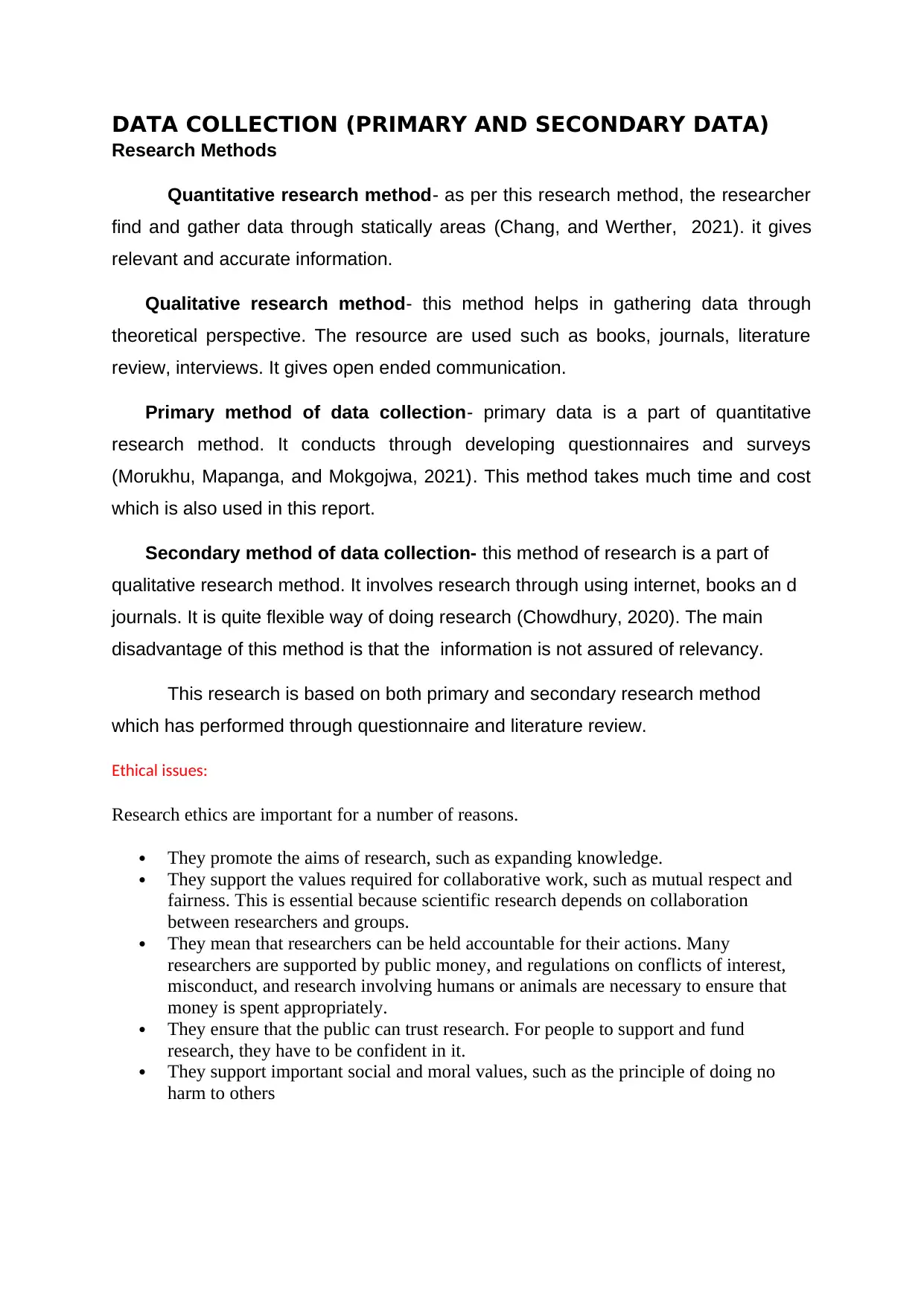
DATA COLLECTION (PRIMARY AND SECONDARY DATA)
Research Methods
Quantitative research method- as per this research method, the researcher
find and gather data through statically areas (Chang, and Werther, 2021). it gives
relevant and accurate information.
Qualitative research method- this method helps in gathering data through
theoretical perspective. The resource are used such as books, journals, literature
review, interviews. It gives open ended communication.
Primary method of data collection- primary data is a part of quantitative
research method. It conducts through developing questionnaires and surveys
(Morukhu, Mapanga, and Mokgojwa, 2021). This method takes much time and cost
which is also used in this report.
Secondary method of data collection- this method of research is a part of
qualitative research method. It involves research through using internet, books an d
journals. It is quite flexible way of doing research (Chowdhury, 2020). The main
disadvantage of this method is that the information is not assured of relevancy.
This research is based on both primary and secondary research method
which has performed through questionnaire and literature review.
Ethical issues:
Research ethics are important for a number of reasons.
They promote the aims of research, such as expanding knowledge.
They support the values required for collaborative work, such as mutual respect and
fairness. This is essential because scientific research depends on collaboration
between researchers and groups.
They mean that researchers can be held accountable for their actions. Many
researchers are supported by public money, and regulations on conflicts of interest,
misconduct, and research involving humans or animals are necessary to ensure that
money is spent appropriately.
They ensure that the public can trust research. For people to support and fund
research, they have to be confident in it.
They support important social and moral values, such as the principle of doing no
harm to others
Research Methods
Quantitative research method- as per this research method, the researcher
find and gather data through statically areas (Chang, and Werther, 2021). it gives
relevant and accurate information.
Qualitative research method- this method helps in gathering data through
theoretical perspective. The resource are used such as books, journals, literature
review, interviews. It gives open ended communication.
Primary method of data collection- primary data is a part of quantitative
research method. It conducts through developing questionnaires and surveys
(Morukhu, Mapanga, and Mokgojwa, 2021). This method takes much time and cost
which is also used in this report.
Secondary method of data collection- this method of research is a part of
qualitative research method. It involves research through using internet, books an d
journals. It is quite flexible way of doing research (Chowdhury, 2020). The main
disadvantage of this method is that the information is not assured of relevancy.
This research is based on both primary and secondary research method
which has performed through questionnaire and literature review.
Ethical issues:
Research ethics are important for a number of reasons.
They promote the aims of research, such as expanding knowledge.
They support the values required for collaborative work, such as mutual respect and
fairness. This is essential because scientific research depends on collaboration
between researchers and groups.
They mean that researchers can be held accountable for their actions. Many
researchers are supported by public money, and regulations on conflicts of interest,
misconduct, and research involving humans or animals are necessary to ensure that
money is spent appropriately.
They ensure that the public can trust research. For people to support and fund
research, they have to be confident in it.
They support important social and moral values, such as the principle of doing no
harm to others
⊘ This is a preview!⊘
Do you want full access?
Subscribe today to unlock all pages.

Trusted by 1+ million students worldwide

LO3 (P5,P6)
RESEARCH ANALYSES WITH COMMUNICATING THE OUTCOME
QUANTITATIVE ANALYSES:
Theme 1: awareness about talent management
Q1. are you aware about why talent management is
required in organisation?
Frequency
Yes 40.00%
No 60.00%
0.00%
60.00%
30.00%
Frequency
Frequency
Interpretation- it has interpreted that 40% of employees of asos are known about
talent management whereas, 60% are still unaware about this fact. These
employees are not actively interested in companies functioning and policies.
Theme 2: Why talent management strategies are needed in Asos plc?
Q2. Why talent management strategies are needed in Asos
plc?
Frequency
(a) To retain and sustain employees for long term. 60.00%
RESEARCH ANALYSES WITH COMMUNICATING THE OUTCOME
QUANTITATIVE ANALYSES:
Theme 1: awareness about talent management
Q1. are you aware about why talent management is
required in organisation?
Frequency
Yes 40.00%
No 60.00%
0.00%
60.00%
30.00%
Frequency
Frequency
Interpretation- it has interpreted that 40% of employees of asos are known about
talent management whereas, 60% are still unaware about this fact. These
employees are not actively interested in companies functioning and policies.
Theme 2: Why talent management strategies are needed in Asos plc?
Q2. Why talent management strategies are needed in Asos
plc?
Frequency
(a) To retain and sustain employees for long term. 60.00%
Paraphrase This Document
Need a fresh take? Get an instant paraphrase of this document with our AI Paraphraser
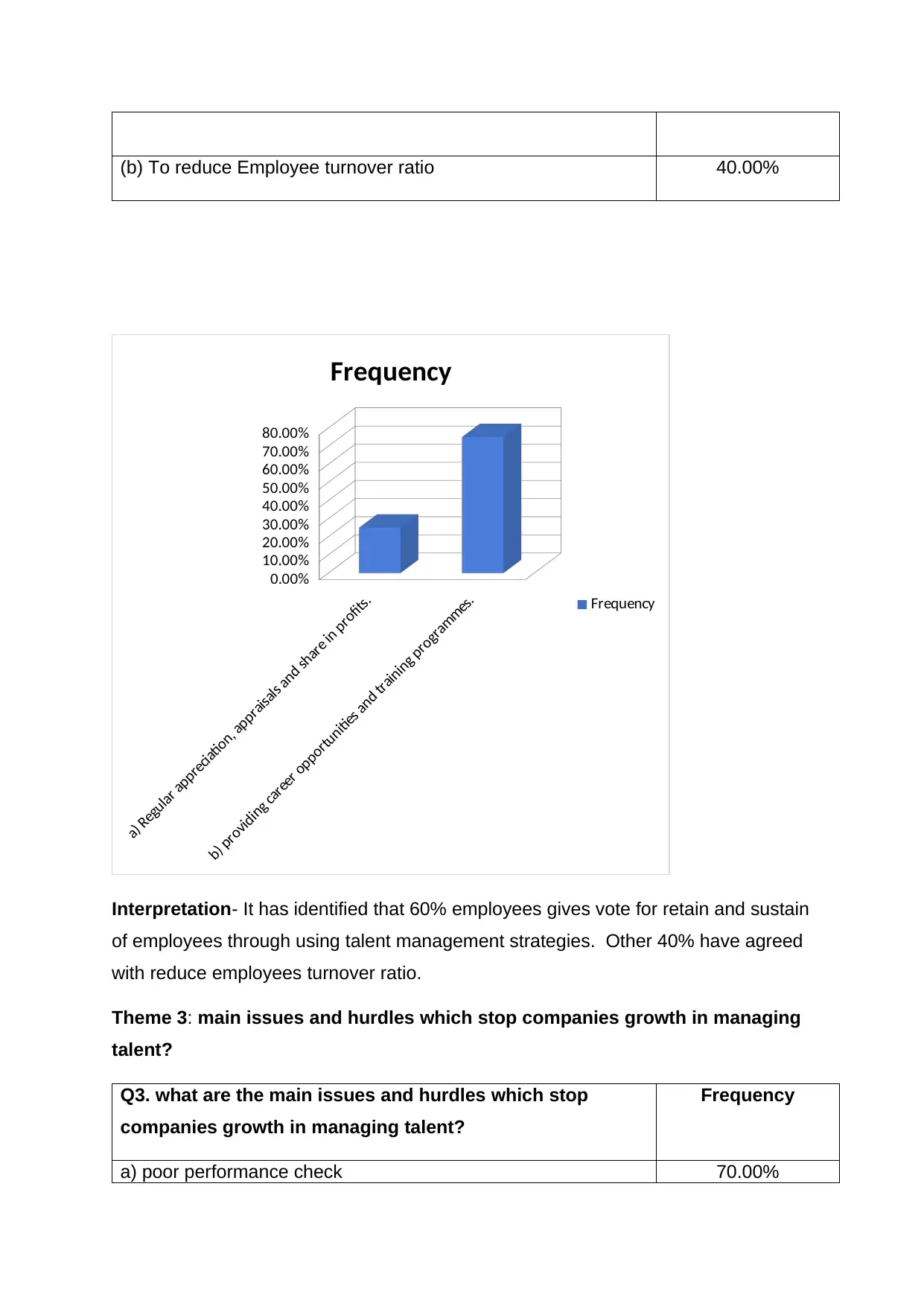
(b) To reduce Employee turnover ratio 40.00%
a) Regular appreciation, appraisals and share in profits.
b) providing career opportunities and training programmes.
0.00%
10.00%
20.00%
30.00%
40.00%
50.00%
60.00%
70.00%
80.00%
Frequency
Frequency
Interpretation- It has identified that 60% employees gives vote for retain and sustain
of employees through using talent management strategies. Other 40% have agreed
with reduce employees turnover ratio.
Theme 3: main issues and hurdles which stop companies growth in managing
talent?
Q3. what are the main issues and hurdles which stop
companies growth in managing talent?
Frequency
a) poor performance check 70.00%
a) Regular appreciation, appraisals and share in profits.
b) providing career opportunities and training programmes.
0.00%
10.00%
20.00%
30.00%
40.00%
50.00%
60.00%
70.00%
80.00%
Frequency
Frequency
Interpretation- It has identified that 60% employees gives vote for retain and sustain
of employees through using talent management strategies. Other 40% have agreed
with reduce employees turnover ratio.
Theme 3: main issues and hurdles which stop companies growth in managing
talent?
Q3. what are the main issues and hurdles which stop
companies growth in managing talent?
Frequency
a) poor performance check 70.00%
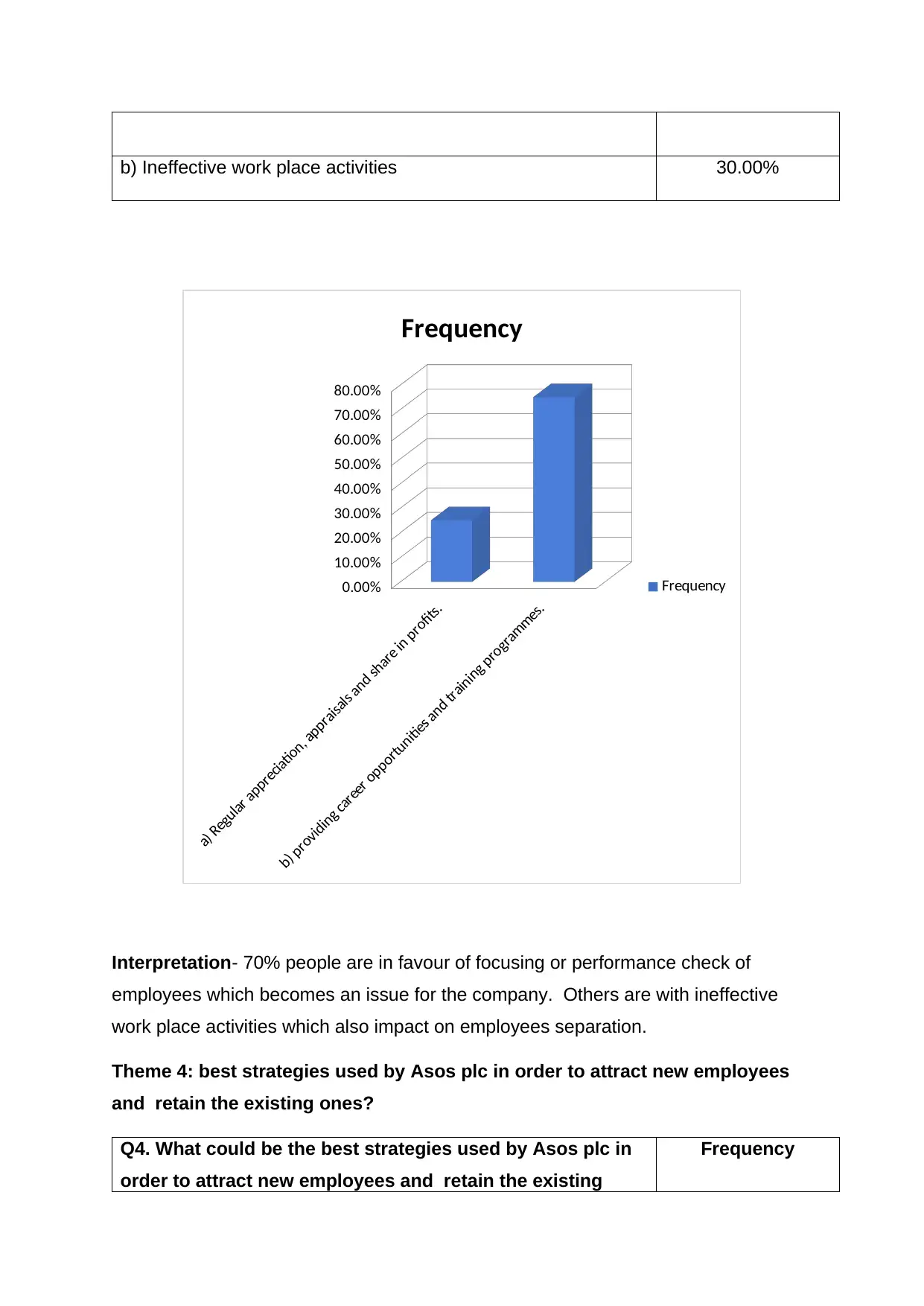
b) Ineffective work place activities 30.00%
a) Regular appreciation, appraisals and share in profits.
b) providing career opportunities and training programmes.
0.00%
10.00%
20.00%
30.00%
40.00%
50.00%
60.00%
70.00%
80.00%
Frequency
Frequency
Interpretation- 70% people are in favour of focusing or performance check of
employees which becomes an issue for the company. Others are with ineffective
work place activities which also impact on employees separation.
Theme 4: best strategies used by Asos plc in order to attract new employees
and retain the existing ones?
Q4. What could be the best strategies used by Asos plc in
order to attract new employees and retain the existing
Frequency
a) Regular appreciation, appraisals and share in profits.
b) providing career opportunities and training programmes.
0.00%
10.00%
20.00%
30.00%
40.00%
50.00%
60.00%
70.00%
80.00%
Frequency
Frequency
Interpretation- 70% people are in favour of focusing or performance check of
employees which becomes an issue for the company. Others are with ineffective
work place activities which also impact on employees separation.
Theme 4: best strategies used by Asos plc in order to attract new employees
and retain the existing ones?
Q4. What could be the best strategies used by Asos plc in
order to attract new employees and retain the existing
Frequency
⊘ This is a preview!⊘
Do you want full access?
Subscribe today to unlock all pages.

Trusted by 1+ million students worldwide
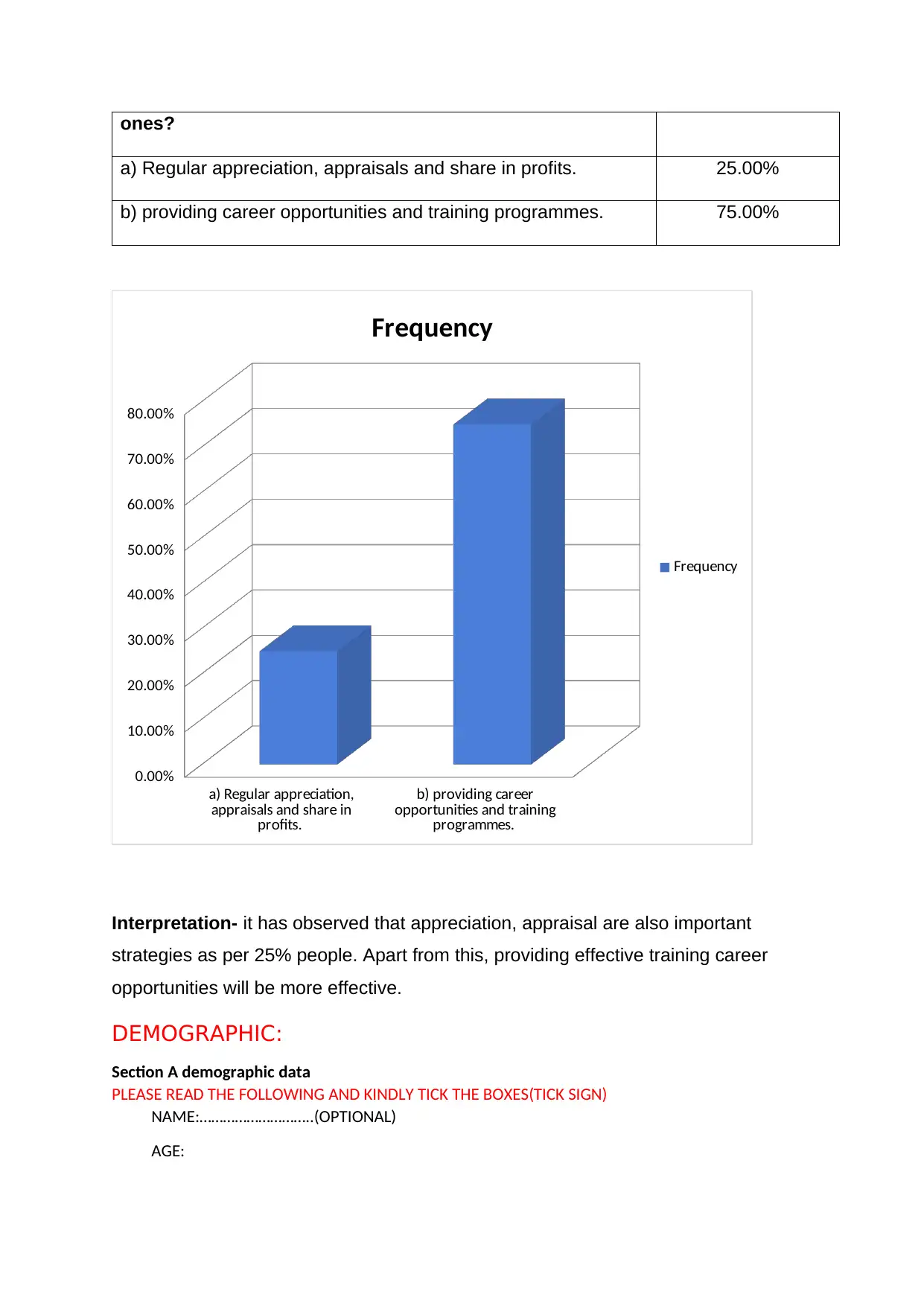
ones?
a) Regular appreciation, appraisals and share in profits. 25.00%
b) providing career opportunities and training programmes. 75.00%
a) Regular appreciation,
appraisals and share in
profits.
b) providing career
opportunities and training
programmes.
0.00%
10.00%
20.00%
30.00%
40.00%
50.00%
60.00%
70.00%
80.00%
Frequency
Frequency
Interpretation- it has observed that appreciation, appraisal are also important
strategies as per 25% people. Apart from this, providing effective training career
opportunities will be more effective.
DEMOGRAPHIC:
Section A demographic data
PLEASE READ THE FOLLOWING AND KINDLY TICK THE BOXES(TICK SIGN)
NAME:………………………..(OPTIONAL)
AGE:
a) Regular appreciation, appraisals and share in profits. 25.00%
b) providing career opportunities and training programmes. 75.00%
a) Regular appreciation,
appraisals and share in
profits.
b) providing career
opportunities and training
programmes.
0.00%
10.00%
20.00%
30.00%
40.00%
50.00%
60.00%
70.00%
80.00%
Frequency
Frequency
Interpretation- it has observed that appreciation, appraisal are also important
strategies as per 25% people. Apart from this, providing effective training career
opportunities will be more effective.
DEMOGRAPHIC:
Section A demographic data
PLEASE READ THE FOLLOWING AND KINDLY TICK THE BOXES(TICK SIGN)
NAME:………………………..(OPTIONAL)
AGE:
Paraphrase This Document
Need a fresh take? Get an instant paraphrase of this document with our AI Paraphraser

25-30 BOX
30-35 BOX
35-40 BOX
>40 BOX
3. GENDER:
MALE BOX
FEMALE BOX
4.EDUCATION:
……….. BOX
…………. BOX
………… BOX
5.INCOME
No income ( )
$15000- $25000 ( )
$26000- $40000 ( )
6. JOB STATUS:
Secondary eduction ()
Higher education ( )
post graduation ( )
PLEASE READ THE FOLLOWING AND KINDLY TICK THE BOXES(TICK SIGN)
Section C
What are the benefits of talent management strategies?
Talent management strategies are beneficial for the organisation. It will help in keeping
employees satisfied, motivated and stick to their goals. It is beneficial for hiring best suitable
candidates which will fulfil organisation requirement. It leads to carry out recruitment and selection.
Where the talent management strategies will be applicable?
Talent management strategy are mainly applicable in HR department to take decision for
training and compensation.
QUALITATIVE ANALYSIS
Literature Review
according to the (Breaugh, 2021) talent management is one of the crucial practices
which needs to be performed by very organisation. The strategies must involve and
consider the employee retention and how could organisation attract new talent
employees. They are the only doer of company and their efforts will make them win
in competitive market. Therefore, strategies like employees performance check,
30-35 BOX
35-40 BOX
>40 BOX
3. GENDER:
MALE BOX
FEMALE BOX
4.EDUCATION:
……….. BOX
…………. BOX
………… BOX
5.INCOME
No income ( )
$15000- $25000 ( )
$26000- $40000 ( )
6. JOB STATUS:
Secondary eduction ()
Higher education ( )
post graduation ( )
PLEASE READ THE FOLLOWING AND KINDLY TICK THE BOXES(TICK SIGN)
Section C
What are the benefits of talent management strategies?
Talent management strategies are beneficial for the organisation. It will help in keeping
employees satisfied, motivated and stick to their goals. It is beneficial for hiring best suitable
candidates which will fulfil organisation requirement. It leads to carry out recruitment and selection.
Where the talent management strategies will be applicable?
Talent management strategy are mainly applicable in HR department to take decision for
training and compensation.
QUALITATIVE ANALYSIS
Literature Review
according to the (Breaugh, 2021) talent management is one of the crucial practices
which needs to be performed by very organisation. The strategies must involve and
consider the employee retention and how could organisation attract new talent
employees. They are the only doer of company and their efforts will make them win
in competitive market. Therefore, strategies like employees performance check,

appreciation and rewards, maintaining positive workplace and encourage career
opportunities are play important role in managing talent.
RECOMMENDATION/SUGGESTIONS:
There is need to perform best job interviews and hiring process in order to fulfil vacant
position in Asos. The candidates must be hire as per their knowledge and capability and must have
ability to cope in digital environment.
LO4:P7 Reflection
By being a part of this research, I have identified that talent management is an
important concept which is necessary for every individual while working in a
company. I agree that every organisation must implement effective strategies for
welfare of employees.
opportunities are play important role in managing talent.
RECOMMENDATION/SUGGESTIONS:
There is need to perform best job interviews and hiring process in order to fulfil vacant
position in Asos. The candidates must be hire as per their knowledge and capability and must have
ability to cope in digital environment.
LO4:P7 Reflection
By being a part of this research, I have identified that talent management is an
important concept which is necessary for every individual while working in a
company. I agree that every organisation must implement effective strategies for
welfare of employees.
⊘ This is a preview!⊘
Do you want full access?
Subscribe today to unlock all pages.

Trusted by 1+ million students worldwide
1 out of 19
Related Documents
Your All-in-One AI-Powered Toolkit for Academic Success.
+13062052269
info@desklib.com
Available 24*7 on WhatsApp / Email
![[object Object]](/_next/static/media/star-bottom.7253800d.svg)
Unlock your academic potential
Copyright © 2020–2025 A2Z Services. All Rights Reserved. Developed and managed by ZUCOL.





